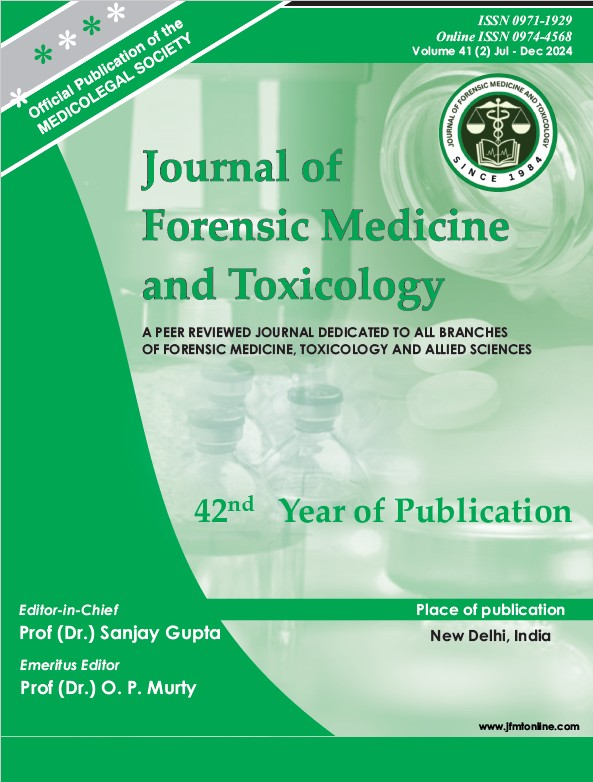Suicidal Death Due to Double-Barreled Shotgun Wound with Muzzle Imprint: An Interesting Case Report
DOI:
https://doi.org/10.48165/jfmt.2025.42.3.23Keywords:
Muzzle imprint, Contact range, SuicideAbstract
This report presents an unusual case of firearm-related death in a 40-year-old male. Autopsy examination revealed bloodstained clothing and a split laceration measuring 15 × 2.5 cm x bone deep over the chin, consistent with a firearm entry wound. The wound had irregular margins, cherry-red discoloration of underlying tissues, and a comminuted mandibular fracture. Multiple teeth were broken, and fractures were noted in the nasal bone. The oral cavity also showed cherry-red discoloration. Blackening of the skin, non-removable on wiping and without singeing of surrounding hair, was noted along the upper edge of the lacerated wound. A semicircular muzzle imprint was present 1.9 cm to the right, with its lower margin adjoining the wound. The entry wound was located 152 cm above the heel. Scalp examination revealed ecchymosis, with multiple fractures of varying dimensions on the outer and inner tables of the skull. The dura was torn in several places. Numerous pellets were found dispersed in the cranial cavity, after striking the base of the skull, along with a plastic wad in the left parietal region of the brain. Both subarachnoid and subdural hemorrhages were present all over the brain at places. Internal organs appeared pale on cut section. Based on the autopsy findings and circumstantial evidence, the cause of death was determined to be craniocerebral trauma due to a firearm injury. The pattern and characteristics of the injuries were consistent with a contact-range shot and supported the conclusion of a suicidal manner of death.
Downloads
References
Shrestha, R., Kanchan, T., & Krishan, K. Gunshot wounds forensic pathology [Internet]. In: StatPearls. Treasure Island (FL): StatPearls Publishing; 2025 Jan– [updated 2023 Apr 17; cited 2025 Jun 21]. Available from: https://www.ncbi.nlm.nih.gov/books/NBK556119/
Aggrawal, A. Textbook of Forensic Medicine and Toxicology. 2nd ed. New Delhi: Arya Publishing Company; p. 277–281, 297–298.
Kalra, B., Vashist, K. V., Malik, Y., Chawla, R., Garg, R., Garg, A., et al. (2019). Suicidal shotgun wound on chest – an unusual entity. Journal of Indian Academy of Forensic Medicine, 41(2), 134–135.
Yadav, A., Swain, R., Bakshi, M. S., & Gupta, S. (2015). Suicidal shotgun wound on chest: an uncommon site with an unusual track. Journal of Indian Academy of Forensic Medicine, 37(4), 430–432.
Demirci, S., Dogan, K. H., Deniz, I., & Erkol, Z. (2014). Evaluation of shotgun suicides in Konya, Turkey between 2000 and 2007. American Journal of Forensic Medicine and Pathology, 35(1), 45–49.
Druid, H. (1999). Site of entrance wound and direction of bullet path in firearm fatalities as indicators of homicide versus suicide. Forensic Science International, 88, 147–162.
Stone, I. C. (1992). Characteristics of firearms and gunshot wounds as markers of suicide. American Journal of Forensic Medicine and Pathology, 13(4), 275–280.




